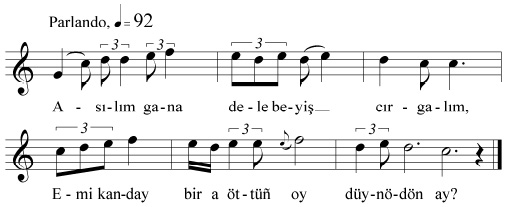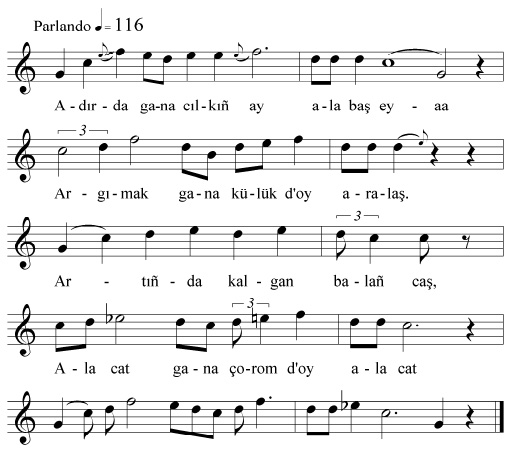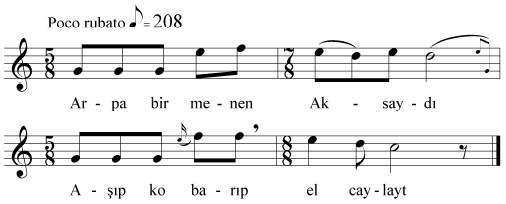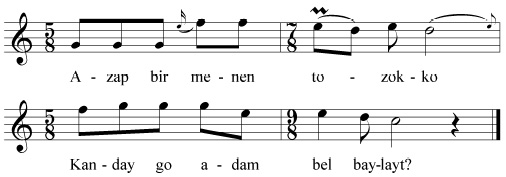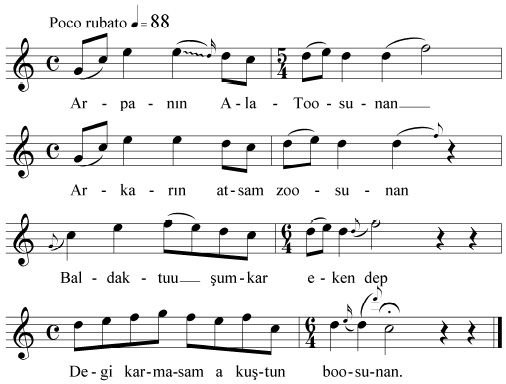- 1. Twin-bar tunes (ex.1-11, №1-58)
- Twin-bar tunes based on the g,-c bichord
- Twin-bar tunes based on rotating motifs
- Twin-bar tunes with descending/hill-shaped lines
- Motifs with a downward leap at the end of the line
- Motivic processes
- 2. Tunes moving on Ionian scales (ex.12-24, №59-164))
- Laments and their relatives
- Two-lined tunes of Major character with higher main cadences and their four-lined relatives
- Four-lined tunes of Major character
- 3. Aeolian tunes (ex.25-36, №165-238)
- Laments and related tunes
- Aeolian tunes with higher main cadence
- Four-lined tunes of Minor character
- Valley-shaped, ascending or undulating first line
- 4. Caramazan religious tunes (ex.37-41, №239-326)
- 5. Tunes of domed structure (ex.42-43, №327-332)
2. Tunes moving on Ionian scales (ex.12-24, №59-164)
2.1. Laments and their relatives (ex.12-16, №59-113)
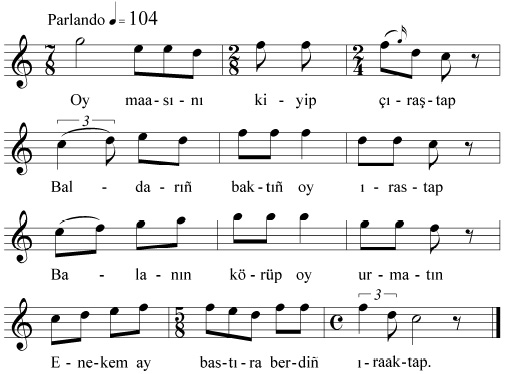


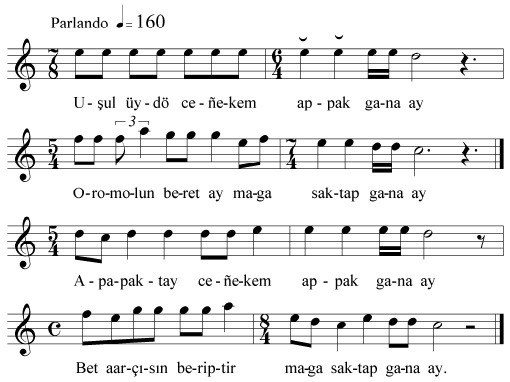


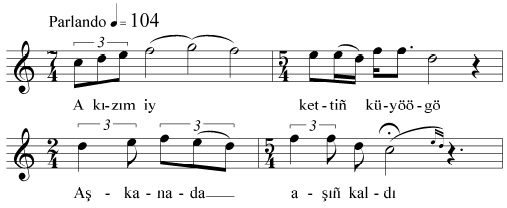
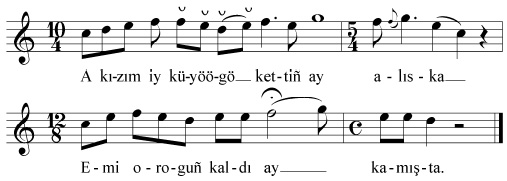


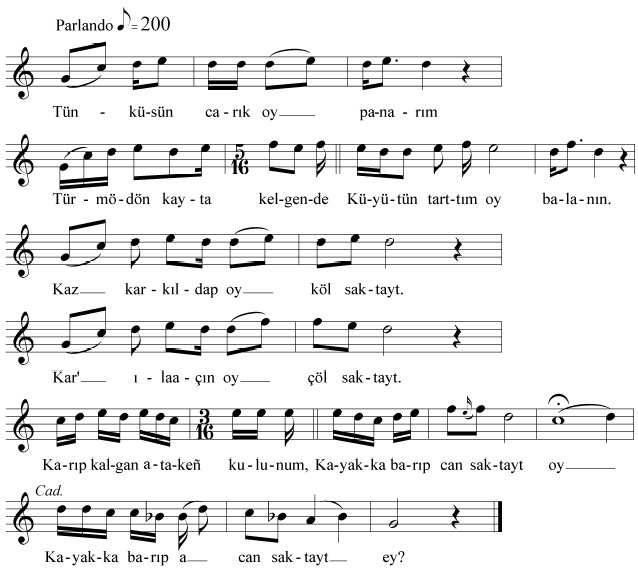

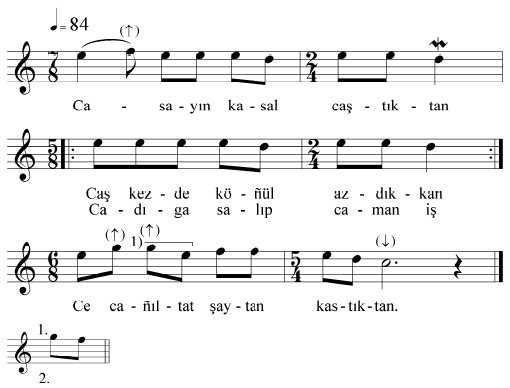


Laments constitute an ancient and important layer of folk musics, being perhaps the most resistant genre to time. The first group of the second block of Kyrgyz tunes contains laments and structually more or less related tunes whose genres belong here without doubt, such as the kız uzatuu ‘bride’s farewellʼ. The rest of the tunes (whose genre is not lament) are arranged here for their melody outline and structure. Similarly to laments, they have two descending or hill-shaped lines one under the other, cadencing on neighbouring notes, performed at times in a free and improvisatory manner or showing at least traces of it.
Just like in twin-bar tunes, the intonation of the pitches is not accurate in the laments, especially the third can shift between minor, major or neutral. The main tendency of intonation can however usually be discerned in the laments. Anyway, there is a close connection between the Aeolian and Ionian laments: in some cases they cannot even be separated and could have been discussed in one category.
2.1.1. Single-lined Major-scale lament and its relatives (ex.12, №59-67). The simplest form of Kyrgyz laments and bride’s laments consists in a freely performed line of Major character and its variants. The lines trace a hill of C-D-E-F-|D-D-E-F-E-D-|C character which may be preceded by a G,-C leap upward or followed by a C-G, leap downward. I ranged in this group of few tunes of similarly built longer lines and rubato performance (№66-67).
2.1.2-3. Lamenting tunes with b3(b3)4 and b3(4)b3/4 cadences (ex.13a-b, №68-73 and №74-78)
The mostly (poco) rubato performed tunes of this group include laments, life-songs and other traditional genres. The starting and closing lines of the tunes are related to the one-lined laments, while their second and third lines feature the D (sometimes E) cadence. This brings them closer to the two-lined laments, in which convex lines cadencing on D or C follow one another, though in the stricter formulae of ABAA, ABBA or AABA. At the end of №76 and №78 we find the D-B-G, descent, which is strongly reminiscent of the sinking line-ends of Hungarian and Anatolian laments.
a)

2.1.4. Two-lined laments of Major character and kindred tunes (ex.14a-b, №79-83). The two-core form of Kyrgyz laments is characterized by descending or convex, mostly parlando-rubato performed lengthier lines cadencing on D and C (ex.14a). The melodies or lamenting processes usually end on C with some closing on D (ex.14b). All this compares the Kyrgyz laments quite closely to the Anatolian, Azeri or, for that matter, to the Hungarian laments, although the more marked hill-shape lends the Kyrgyz laments a somewhat different character.
2.1.5. Lamenting tunes with 4(4)4/b3 cadences (ex.14c, №84-87). Laments with 4(4)4/b3 cadences are closely linked to the two-lined laments (ex.14c). Of them the Kyrgyz tune descending to G, and Toktogul’s Beş kaman song mentioned in the chapter on Toktogul’s art is broadly coincidental with the enlarged form of Hungarian laments.
Finally, let me present two small groups of tunes:
2.1.6. Lamenting tunes with (5) cadence, comprising two lines or retraceable to two-lined forms (№88-89),
2.1.7. Lamenting tunes with 4(b3)x cadences (ex.14d, №90).
a)

b)


c)

There is a large and significant group of Kyrgyz folk music the tunes of which display kinship with the above outlined two-core laments by virtue of their layout, main cadences and free improvisatory performing character. Some are performed poco rubato, but the stricter performance can also be heard. Their lines are shorter than the lament lines and many tunes are isometric or quasi-isometric. Certain segments of the melody outline in some of them also deviate from the customary turns in laments.
They divide into two main groups according to their cadential sequence which also reflects their melody progression to some degree.
2.1.8. Isometric shorter lines with 4-b3 + 4-b3 cadences (ex.15, №91-98). These tunes of AB and AB|AB pattern resembling laments have basically shorter lines and are often performed poco rubato but in the background a fixed rhythmic scheme e.g. €&|@@$ or €€|~@$ can be made out quite clearly. Recitation is rare, but the rigidly fixed rhythmic pattern is also rare.
2.1.9. Shorter lines with 4(4)4 or 4(4)b3 cadences (ex.16a-b, №99-109). There are songs of AAAB or AABC form with 4(4)4 or 4(4)b3 cadences, some performed parlando-rubato and some giusto. They include some Manas recitations (ex.16a), laments and several variants of the Ak Kepter song (ex. 16b). Lines with D and C candences alternate, but while some lines rotate around some pivotal note, others descend or outline a bulge. What differentiates this group from the previous one is that here the typical re→do candential change of two-core laments only occurs in the third/fourth line while in the former group it already takes place in the second. At the end of the lines a glide to the 6th degree is not rare, and the end of the third line is highly variable here, too. All this notwithstanding, their structure and melody contour place these tunes next to the Kyrgyz laments.
a)

2.1.10. Lamenting tunes beginning around the 8th-10th degree (№110-113). Tunes beginning with short lines daring the height of the 8th-10th degrees are not frequent among Kyrgyz laments and in the traditional Kyrgyz repertory in general. However, since this high register is customary in the Hungarian and Anatolian lament style, I present a few examples in the anthology (№110-113).
1 ex.12, Lament (Koşok), Toytuyeva Salika (1928, Kara-Buluñ), Sarıbağış, At-Başı, 2004
2 ex.13a, Lament (Koşok), Abdrahmanova Kakış (1928, Barskoon), Buğu-Bapa, Darhan, 2002; ex.13b, Lament (Koşok), Abdıldayev Şükür (1933, Barskoon), Buğu-Bapa, Barskoon yayla, 2002
3 ex.14a, Lament (Koşok), İmanaliyeva Kalıy (1929), Kuşçu, Aral, 2004; ex.14b, Farewell to the bride, Atıkanova Masılkan (1936, Miñ-Bulak), Saruu, Köpüröbazar, 2004; ex.14c, Lament (Toktogul’s), Asek Jumabay-uulu (77), Tınımseyit, 2001, Baykazak, Narın, coll. of D. Somfai Kara 2001; ex.14d, Lament (to her husband), Kubanıçbek Kojoyev (1948, Narin) Çerik-Duban, At-Başı, 2002
4 ex.15, Song of young people, Şonkoyeva Tursun (1935, Terek-Suu), Çerik, Kara-Suu, 2004
5 ex.16a, Terme-Sanat, Murataalı uulu Nurdin (1923), China, Çerik-Sazan, Baş-Kayıñdı, 2002; ex.16b, Folksong White Falcon, Toktosopiyev Mambetalı (1927), Sarıbağış, Kara-Koyun, 2004

